Genome-Wide Characterization of 9-Cis-Epoxycarotenoid Dioxygenase Genes in Luffa Identifies LcNCED2 as Being Associated with ABA Levels During Seed Germination
Abstract
1. Introduction
2. Materials and Methods
2.1. Plant Materials and Germination Analysis
2.2. Analysis of α-Amylase Activity
2.3. Identification of LcNCED and LaNCED Gene Members
2.4. Determination of Gene Structure, Conserved Motifs and Potential Cis-Elements
2.5. Chromosome Localization and Phylogenetic Analysis of NCED Proteins
2.6. Expression Analysis Performed by Quantitative Real-Time PCR (qRT-PCR)
2.7. Analysis of Subcellular Localization
2.8. Analysis of ABA Content
2.9. Statistical Analysis
3. Results
3.1. Identification of the LcNCED and LaNCED Gene Family Members
3.2. Chromosomal Distribution and Phylogenetic Analysis
3.3. Genetic Structure and Conserved Motifs of the LaNCED and LcNCED Gene Families
3.4. Analysis of Cis-Elements in LaNCED and LcNCED Gene Promoters
3.5. Expression Patterns of LcNCEDs During the Germination of L. cylindrica
3.6. Analysis of Enzyme Activity for LcNCED2
4. Discussion
5. Conclusions
Supplementary Materials
Author Contributions
Funding
Data Availability Statement
Conflicts of Interest
References
- Brookbank, B.P.; Patel, J.; Gazzarrini, S.; Nambara, E. Role of basal aba in plant growth and development. Genes 2021, 12, 1936. [Google Scholar] [CrossRef] [PubMed]
- Chen, K.; Li, G.J.; Bressan, R.A.; Song, C.P.; Zhu, J.K.; Zhao, Y. Abscisic acid dynamics, signaling, and functions in plants. J. Integr. Plant Biol. 2019, 62, 25–54. [Google Scholar] [CrossRef] [PubMed]
- Wu, W.; Cao, S.; Shi, L.; Chen, W.; Yin, X.; Yang, Z. Abscisic acid biosynthesis, metabolism and signaling in ripening fruit. Front. Plant Sci. 2023, 14, 1279031. [Google Scholar] [CrossRef] [PubMed]
- Taylor, I.B.; Alan, B.; Thompson, A.J. Control of abscisic acid synthesis. J. Exp. Bot. 2000, 51, 1563–1574. [Google Scholar] [CrossRef] [PubMed]
- González-Guzmán, M.; Apostolova, N.; Bellés, J.M.; Barrero, J.M.; Piqueras, P.; Ponce, M.R.; Rodriguez, P.L. The short-chain alcohol dehydrogenase ABA2 catalyzes the conversion of xanthoxin to abscisic aldehyde. Plant Cell 2002, 14, 1833–1846. [Google Scholar] [CrossRef]
- González-Guzmán, M.; Rodriguez, L.; Lorenzo-Orts, L.; Pons, C.; Sarrion-Perdigones, A.; Fernandez, M.A. Tomato PYR/PYL/RCAR abscisic acid receptors show high expression in root, differential sensitivity to the abscisic acid agonist quinabactin, and the capability to enhance plant drought resistance. J. Exp. Bot. 2014, 65, 4451–4464. [Google Scholar] [CrossRef]
- Aerts, N.; Hickman, R.; Van Dijken, A.J.H.; Kaufmann, M.; Snoek, B.L.; Pieterse, C.M.J.; Van Wees, S.C.M. Architecture and dynamics of the abscisic acid gene regulatory network. Plant J. 2024, 119, 2538–2563. [Google Scholar] [CrossRef]
- Zhou, Q.; Li, Q.; Li, P.; Zhang, S.; Liu, C.; Jin, J.; Yang, Y. Carotenoid cleavage dioxygenases: Identification, expression, and evolutionary analysis of this gene family in tobacco. Int. J. Mol. Sci. 2019, 20, 5796. [Google Scholar] [CrossRef]
- Schwartz, S.H.; Tan, B.C.; Gage, D.A.; Zeevaart, J.A.; McCarty, D.R. Specific oxidative cleavage of carotenoids by VP14 of maize. Science 1997, 276, 1872–1874. [Google Scholar] [CrossRef]
- Chen, K.; Li, X.; Guo, X.; Yang, L.; Qiu, L.; Liu, W.; Zheng, T. Genome-wide identification and expression profiling of the nced gene family in cold stress response of Prunus mume Siebold & Zucc. Horticulturae 2023, 9, 839. [Google Scholar] [CrossRef]
- Wang, R.K.; Wang, C.E.; Fei, Y.Y.; Gai, J.Y.; Zhao, T.J. Genome-wide identification and transcription analysis of soybean carotenoid oxygenase genes during abiotic stress treatments. Mol. Bio. Rep. 2013, 40, 4737–4745. [Google Scholar] [CrossRef] [PubMed]
- Li, Q.H.; Yu, X.T.; Chen, L.; Zhao, G.; Li, S.Z.; Zhou, H.; Dai, Y.; Sun, N.; Xie, Y.F.; Gao, J.S.; et al. Genome-wide identification and expression analysis of the NCED family in cotton (Gossypium hirsutum L.). PLoS ONE 2021, 16, e0246021. [Google Scholar] [CrossRef] [PubMed]
- Chen, X.; Lv, R.; Zhang, Y.; Mo, F.; Meng, F.; Cheng, M.; Wang, A. Identification of the NCED gene family in tomato (Solanum lycopersicum) and functional analysis of SlNCED2 in response to drought stress. Sci. Hortic. 2024, 330, 113087. [Google Scholar] [CrossRef]
- Tan, B.C.; Joseph, L.M.; Deng, W.T.; Liu, L.; Li, Q.B.; Cline, K.; McCarty, D.R. Molecular characterization of the Arabidopsis 9-cis epoxycarotenoid dioxygenase gene family. Plant J. 2003, 35, 44–56. [Google Scholar] [CrossRef]
- Ali, F.; Qanmber, G.; Li, F.; Wang, Z. Updated role of ABA in seed maturation, dormancy, and germination. J. Adv. Res. 2022, 35, 199–214. [Google Scholar] [CrossRef]
- Kanno, Y.; Jikumaru, Y.; Hanada, A.E.; Nambara, S.R.; Abrams, Y.; Kamiya, M.S. Comprehensive hormone profiling in developing Arabidopsis seeds: Examination of the site of ABA biosynthesis, ABA transport and hormone interactions. Plant Cell Physiol. 2010, 51, 1988–2001. [Google Scholar] [CrossRef]
- Frey, A.; Effroy, D.; Lefebvre, V.; Seo, M.; Perreau, F.; Berger, A.; Sechet, J.; To, A.; North, H.M.; Marion-Poll, A. Epoxycarotenoid cleavage by NCED5 fine-tunes ABA accumulation and affects seed dormancy and drought tolerance with other NCED family members. Plant J. 2012, 70, 501–512. [Google Scholar] [CrossRef]
- Lefebvre, V.H.; North, A.; Frey, B.; Sotta, M.; Seo, M.; Okamoto, E.; Nambara, A.; Marion, P. Functional analysis of Arabidopsis NCED6 and NCED9 genesindicates that ABA synthesized in the endosperm is involved in the inductionof seed dormancy. Plant J. 2006, 45, 309–319. [Google Scholar] [CrossRef]
- Saeed, A.; Iqbal, M. Loofa (Luffa cylindrica) sponge: Review of development of the biomatrix as a tool for biotechnological applications. Biotechnol. Prog. 2013, 29, 573–600. [Google Scholar] [CrossRef]
- Shendge, P.N.; Belemkar, S. Therapeutic potential of Luffa acutangula: A review on its traditional uses, phytochemistry, Pharmacology and toxicological aspects. Front. Pharmacol. 2018, 9, 1177. [Google Scholar] [CrossRef]
- Awal, A.; Adam, S.; Shamsuri, S.; Yusuf, N.A.; Ibrahim, N.; Elias, E.Z. Luffa gourd production practices from transplanting and direct seeding methods for composite productions. OP Conf. Ser. Earth Environ. Sci. 2021, 685, 12024. [Google Scholar] [CrossRef]
- Chaodumrikul, S.; Kaewsorn, P.; Chulaka, P.; Chanprasert, W. Breaking seed dormancy in smooth loofah (Luffa cylindrica (L.) M. Roem.) using scarification and dry heat treatment. Agric. Nat. Res. 2016, 50, 85–88. [Google Scholar] [CrossRef][Green Version]
- Priya, R.; Siva, R. Analysis of phylogenetic and functional diverge in plant nine-cis epoxycarotenoid dioxygenase gene family. J. Plant Res. 2015, 128, 519–534. [Google Scholar] [CrossRef] [PubMed]
- Hashemi, M.; Mousavi, S.M.; Razavi, S.H.; Shojaosadati, S.A. Comparison of submerged and solid-state fermentation systems effects on the catalytic activity of Bacillus sp. KR-8104 α-amylase at different pH and temperatures. Ind. Crops Prod. 2013, 43, 661–667. [Google Scholar] [CrossRef]
- Chen, C.; Chen, H.; Zhang, Y.; Thomas, H.R.; Frank, M.H.; He, Y.; Xia, R. TBtools: An integrative toolkit developed for interactive analyses of big biological data. Mol. Plant 2020, 13, 1194–1202. [Google Scholar] [CrossRef]
- Chou, K.C.; Shen, H.B. Plant-mPLoc: A top-down strategy to augment the power for predicting plant protein subcellular localization. PLoS ONE 2010, 5, e11335. [Google Scholar] [CrossRef]
- Hu, B.; Jin, J.; Guo, A.Y.; Zhang, H.; Luo, J.; Gao, G. GSDS 2.0: An upgraded gene features visualization server. Bioinformatics 2015, 31, 1296–1297. [Google Scholar] [CrossRef]
- Lescot, M.; Déhais, P.; Thijs, G.; Marchal, K.; Moreau, Y.; Van de Peer, Y.; Rouzé, P.; Rombauts, S. PlantCARE, a database of plant cis-acting regulatory elements and a portal to tools for in silico analysis of promoter sequences. Nucleic Acids Res. 2002, 30, 325–327. [Google Scholar] [CrossRef]
- Katoh, K.; Misawa, K.; Kuma, K.; Miyata, T. MAFFT: A novel method for rapid multiple sequence alignment based on fast Fourier transform. Nucleic Acids Res. 2002, 30, 3059–3066. [Google Scholar] [CrossRef]
- Løvdal, T.; Lillo, C. Reference gene selection for quantitative real-time PCR normalization in tomato subjected to nitrogen, cold, and light stress. Anal. Biochem. 2009, 387, 238–24228. [Google Scholar] [CrossRef]
- Wang, Z.; Li, X.; Liu, N.; Peng, Q.; Wang, Y.; Fan, B.; Zhu, C.; Chen, Z. A Family of NAI2-interacting proteins in the biogenesis of the ER body and related structures. Plant Physiol. 2019, 180, 212–227. [Google Scholar] [CrossRef] [PubMed]
- Li, Y.; Zhou, C.; Yan, X.; Zhang, J.; Xu, J. Simultaneous analysis of ten phytohormones in Sargassum horneri by high-performance liquid chromatography with electrospray ionization tandem mass spectrometry. J. Sep. Sci. 2016, 39, 1804–1813. [Google Scholar] [CrossRef] [PubMed]
- Pujadas, G.; Palau, J. Evolution of alpha-amylases: Architectural features and key residues in the stabilization of the (beta/alpha) (8) scaffold. Mol. Biol. Evol. 2001, 18, 38–54. [Google Scholar] [CrossRef]
- Liu, L.; Xia, W.; Li, H.; Zeng, H.; Wei, B.; Han, S.; Yin, C. Salinity inhibits rice seed germination by reducing alpha-amylase activity via decreased bioactive gibberellin content. Front. Plant Sci. 2018, 9, 275. [Google Scholar] [CrossRef]
- Zhang, L.; Shi, M.; Ji, J.; Hu, X.; Chen, F. Gut microbiota determines the prevention effects of Luffa cylindrica (L.) Roem supplementation against obesity and associated metabolic disorders induced by high-fat diet. FASEB J. 2019, 33, 10339. [Google Scholar] [CrossRef]
- Sano, N.; Marion-Poll, A. ABA metabolism and homeostasis in seed dormancy and germination. Int. J. Mol. Sci. 2021, 22, 5069. [Google Scholar] [CrossRef]
- Ruggiero, B.; Koiwa, H.; Manabe, Y.; Quist, T.M.; Inan, G.; Saccardo, F.; Joly, R.J.; Hasegawa, P.M.; Bressan, R.A.; Maggio, A. Uncoupling the effects of abscisic acid on plant growth and water relations: Analysis of sto1/nced3, an abscisic acid-deficient but salt stress-tolerant mutant in Arabidopsis. Plant Physiol. 2004, 136, 3134–3147. [Google Scholar] [CrossRef]
- Müller, M. Foes or Friends: ABA and ethylene interaction under abiotic stress. Plants 2021, 10, 448. [Google Scholar] [CrossRef]
- Parwez, R.; Aftab, T.; Gill, S.S.; Naeem, M. Abscisic acid signaling and crosstalk with phytohormones in regulation of environmental stress responses. Environ. Exp. Bot. 2022, 199, 104885. [Google Scholar] [CrossRef]
- Martínez-Andújar, C.; Ordiz, M.I.; Huang, Z.; Nonogaki, M.; Beachy, R.N.; Nonogaki, H. Induction of 9-cis-epoxycarotenoid dioxygenase in Arabidopsis thaliana seeds enhances seed dormancy. Proc. Natl. Acad. Sci. USA 2011, 108, 17225–17229. [Google Scholar] [CrossRef]
- Han, C.; Yang, P. Studies on the molecular mechanisms of seed germination. Proteomics 2015, 15, 1671–1679. [Google Scholar] [CrossRef] [PubMed]
- Helland, M.; Wicklund, T.; Narvhus, J. Effect of germination time on α-amylase production and viscosity of maize porridge. Food Res. Inter. 2002, 35, 315–321. [Google Scholar] [CrossRef]
- Lee, Y.; Chen, M.C.; Lin, L.; Chung, M.C.; Leu, W.M. Increased expression of 9-cis-epoxycarotenoid dioxygenase, PtNCED1, associated with inhibited seed germination in a terrestrial orchid, Phaius tankervilliae. Front. Plant Sci. 2018, 9, 1043. [Google Scholar] [CrossRef] [PubMed]
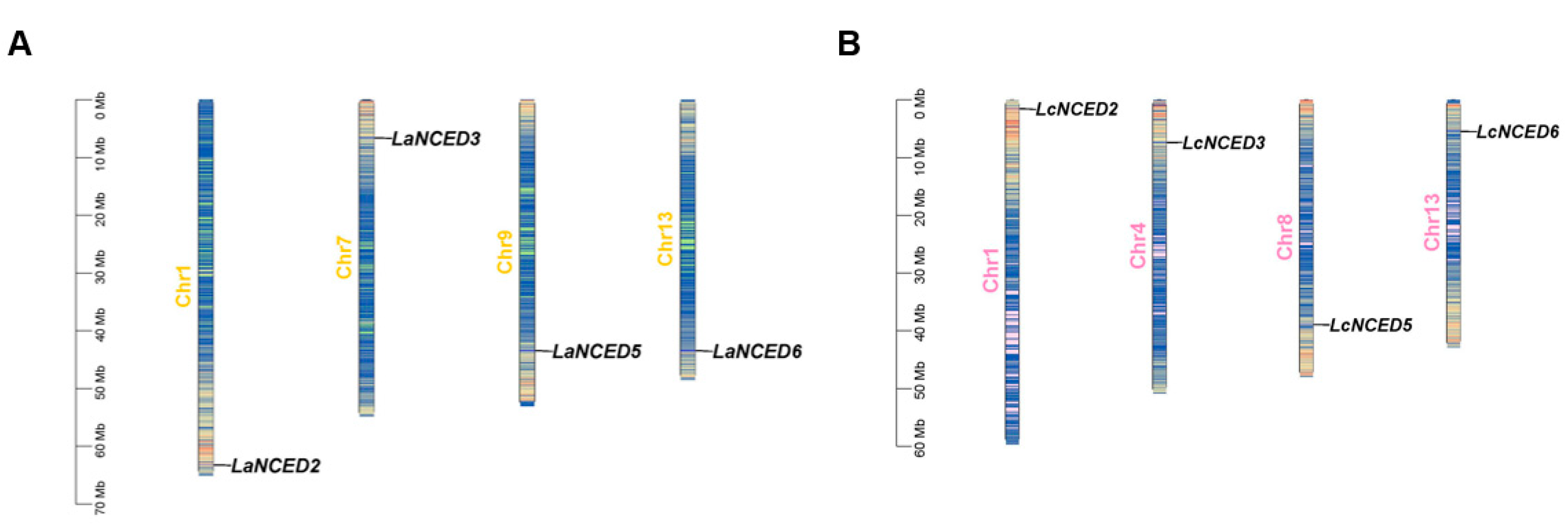
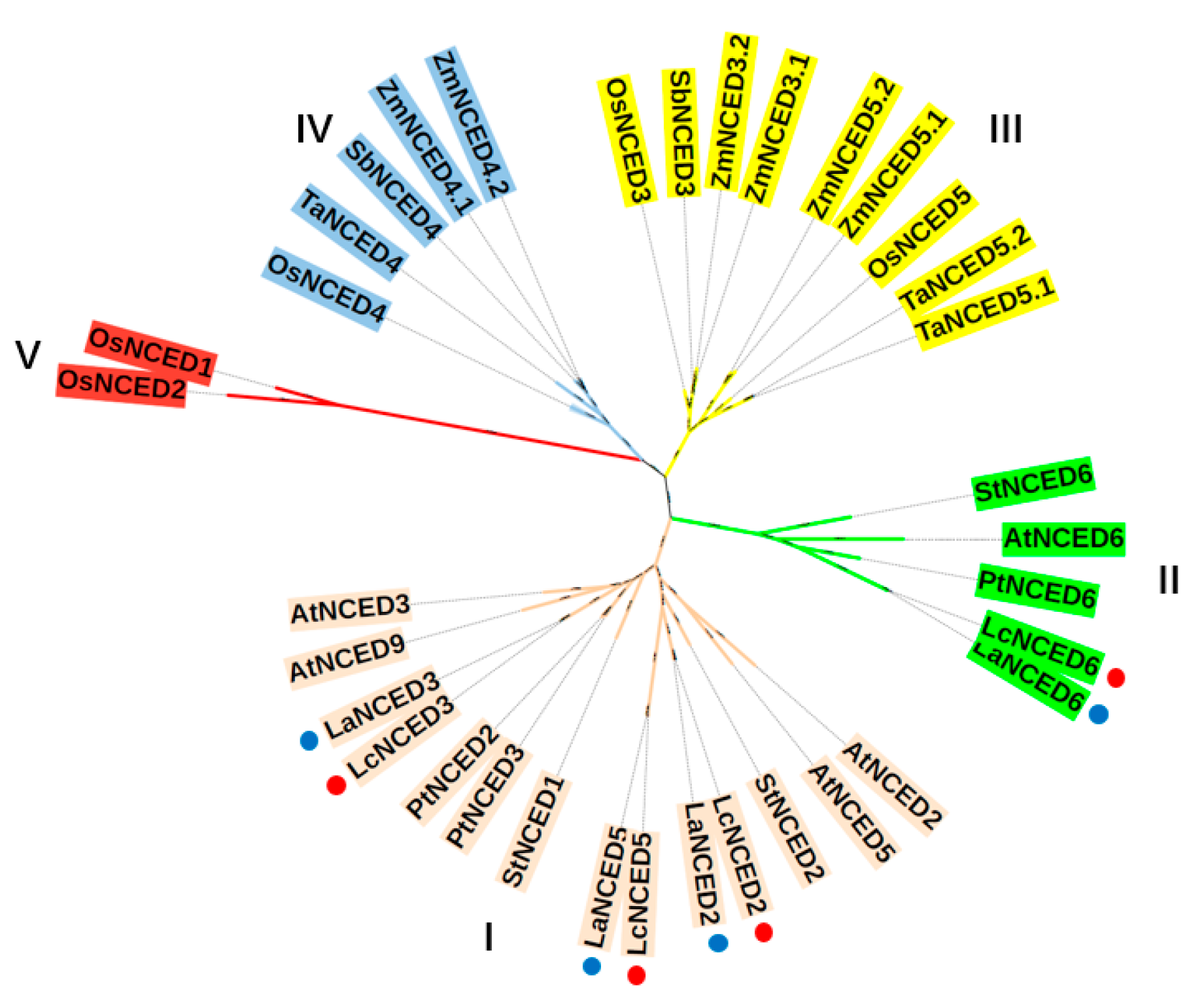
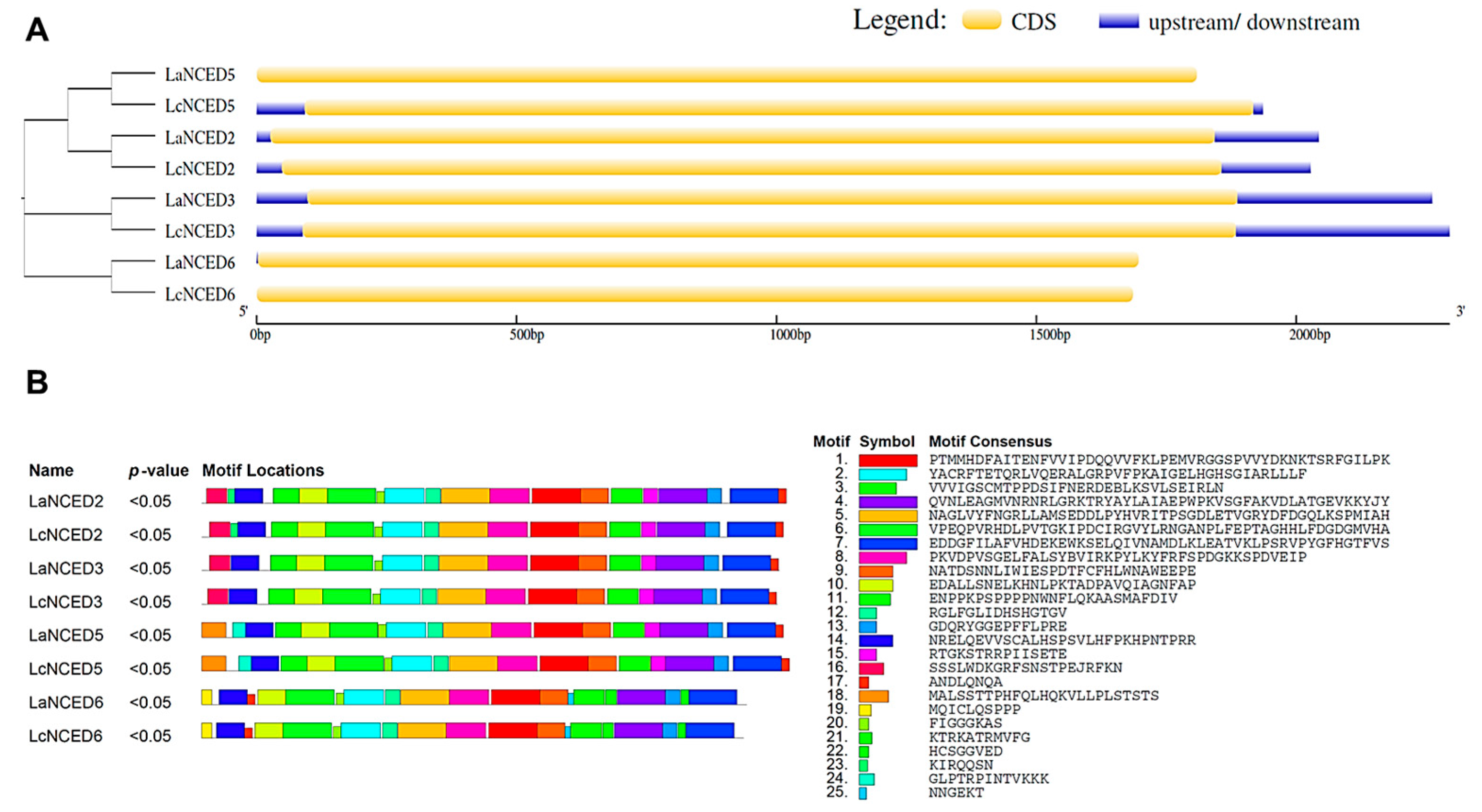
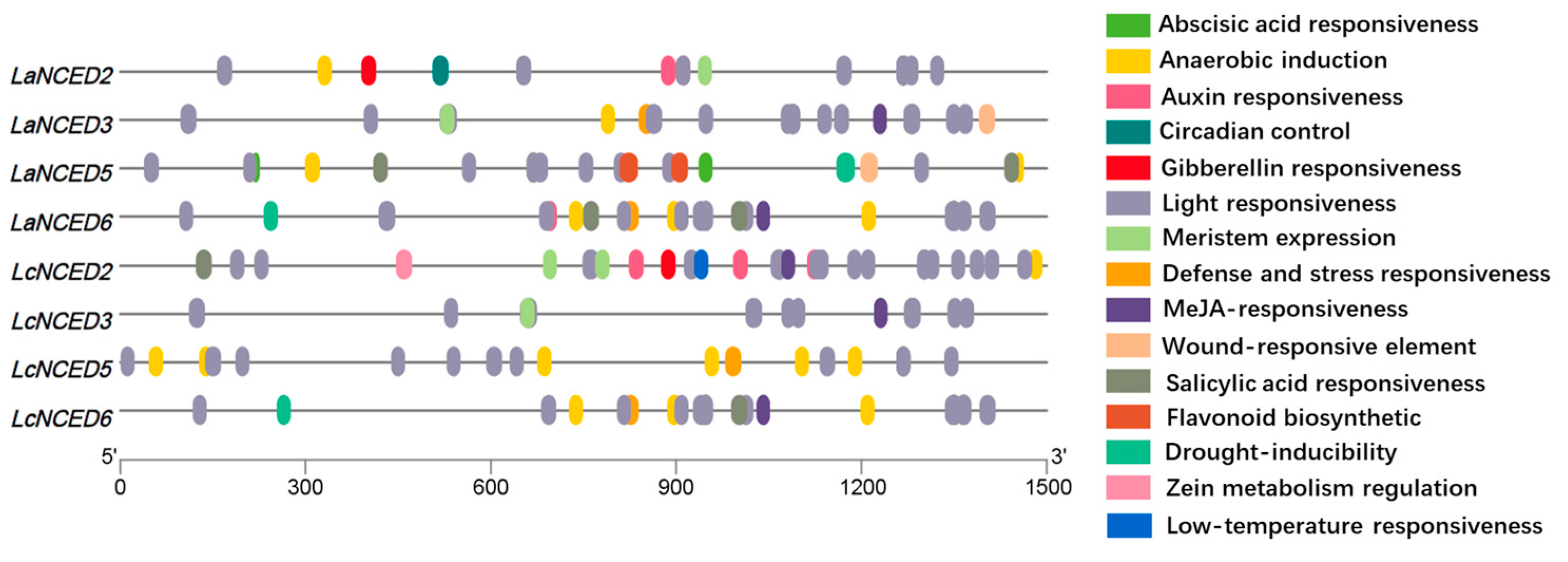
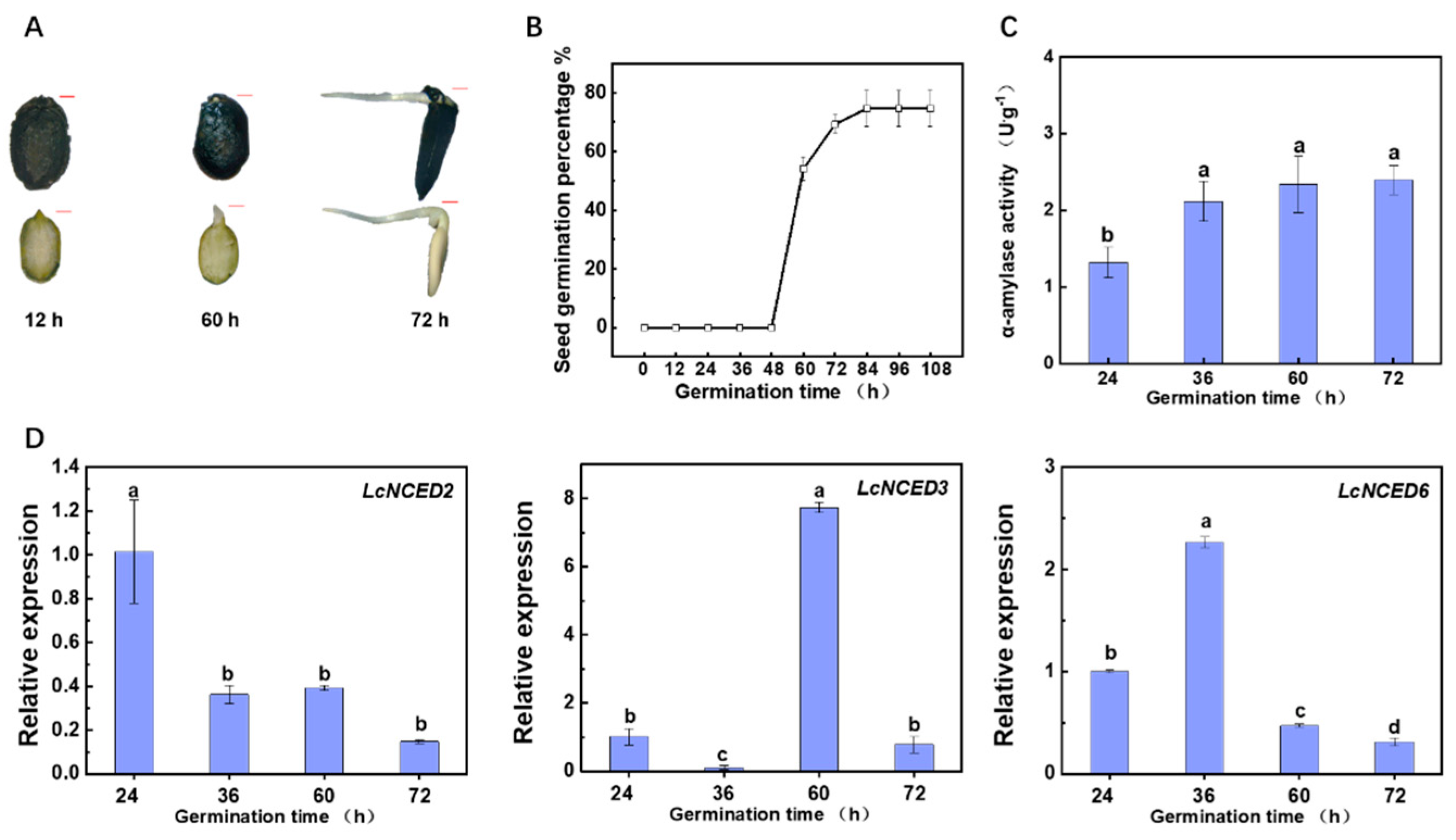
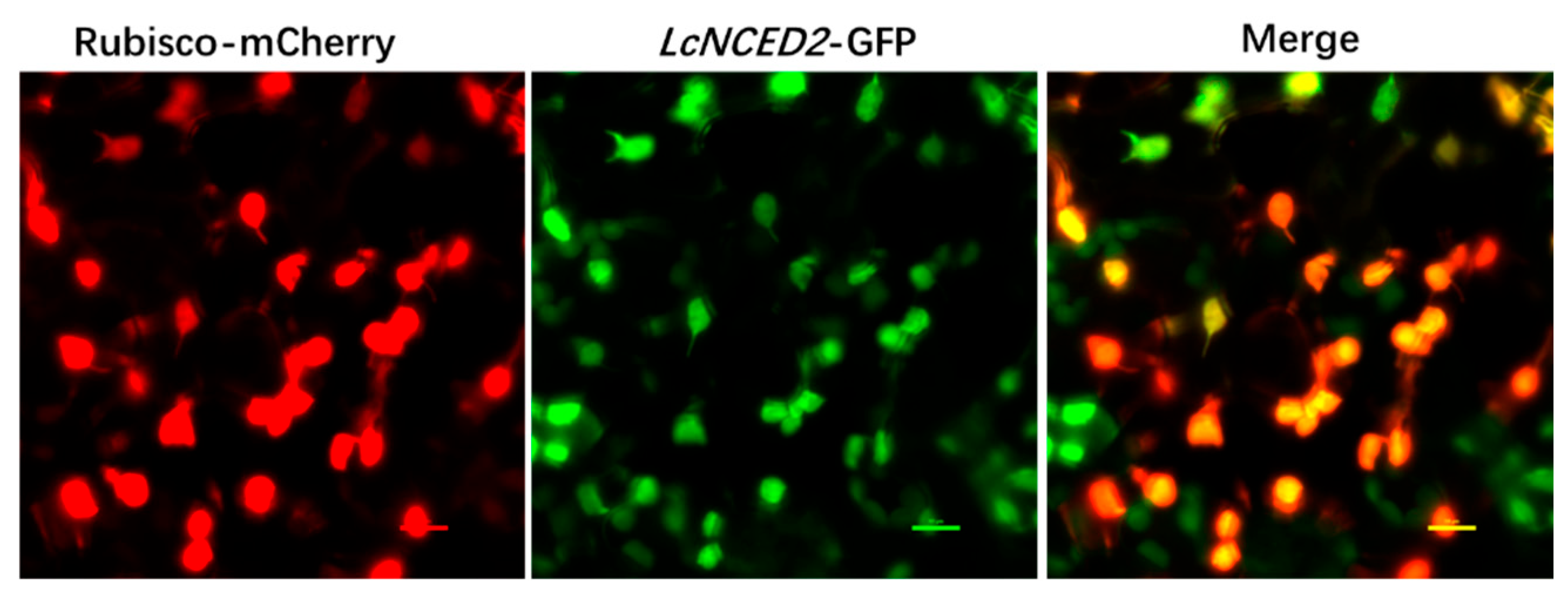

| Gene | Locus | Chr | Group | PL (aa) | MW (Da) | PI | GRAVY | PSL |
|---|---|---|---|---|---|---|---|---|
| LaNCED2 | La_Chr01G24300 | 1 | I | 605 | 67,766.82 | 7.38 | −0.424 | Chl, Cyt |
| LaNCED3 | La_Chr07G06460 | 7 | I | 598 | 66,119.65 | 6.22 | −0.254 | Cyt |
| LaNCED5 | La_Chr09G14380 | 9 | I | 602 | 67,576.27 | 7.35 | −0.310 | Cyt |
| LaNCED6 | La_Chr13G14000 | 13 | II | 564 | 62,032.84 | 7.26 | −0.241 | Cyt |
| LcNCED2 | Lc_Chr01G01420 | 1 | I | 602 | 67,321.32 | 7.08 | −0.388 | Chl, Cyt |
| LcNCED3 | Lc_Chr04G06960 | 4 | I | 596 | 65,793.52 | 6.13 | −0.245 | Cyt |
| LcNCED5 | Lc_Chr08G15230 | 8 | I | 608 | 68,127.57 | 7.31 | −0.282 | Chl, Cyt |
| LcNCED6 | Lc_Chr13G04200 | 13 | II | 561 | 61,711.64 | 6.99 | −0.228 | Cyt |
Disclaimer/Publisher’s Note: The statements, opinions and data contained in all publications are solely those of the individual author(s) and contributor(s) and not of MDPI and/or the editor(s). MDPI and/or the editor(s) disclaim responsibility for any injury to people or property resulting from any ideas, methods, instructions or products referred to in the content. |
© 2025 by the authors. Licensee MDPI, Basel, Switzerland. This article is an open access article distributed under the terms and conditions of the Creative Commons Attribution (CC BY) license (https://creativecommons.org/licenses/by/4.0/).
Share and Cite
Fang, P.; Li, X.; Mu, H.; Wei, J.; Zhang, T.; Wang, X.; Guo, Q.; Lou, Q. Genome-Wide Characterization of 9-Cis-Epoxycarotenoid Dioxygenase Genes in Luffa Identifies LcNCED2 as Being Associated with ABA Levels During Seed Germination. Horticulturae 2025, 11, 115. https://doi.org/10.3390/horticulturae11020115
Fang P, Li X, Mu H, Wei J, Zhang T, Wang X, Guo Q, Lou Q. Genome-Wide Characterization of 9-Cis-Epoxycarotenoid Dioxygenase Genes in Luffa Identifies LcNCED2 as Being Associated with ABA Levels During Seed Germination. Horticulturae. 2025; 11(2):115. https://doi.org/10.3390/horticulturae11020115
Chicago/Turabian StyleFang, Pingping, Xifeng Li, Haoxin Mu, Jing Wei, Ting Zhang, Xueyan Wang, Qinwei Guo, and Qunfeng Lou. 2025. "Genome-Wide Characterization of 9-Cis-Epoxycarotenoid Dioxygenase Genes in Luffa Identifies LcNCED2 as Being Associated with ABA Levels During Seed Germination" Horticulturae 11, no. 2: 115. https://doi.org/10.3390/horticulturae11020115
APA StyleFang, P., Li, X., Mu, H., Wei, J., Zhang, T., Wang, X., Guo, Q., & Lou, Q. (2025). Genome-Wide Characterization of 9-Cis-Epoxycarotenoid Dioxygenase Genes in Luffa Identifies LcNCED2 as Being Associated with ABA Levels During Seed Germination. Horticulturae, 11(2), 115. https://doi.org/10.3390/horticulturae11020115





